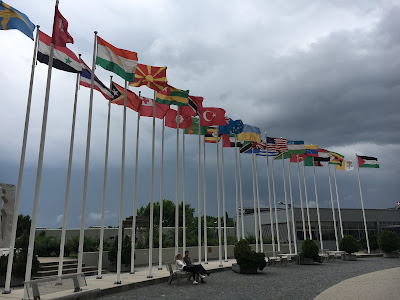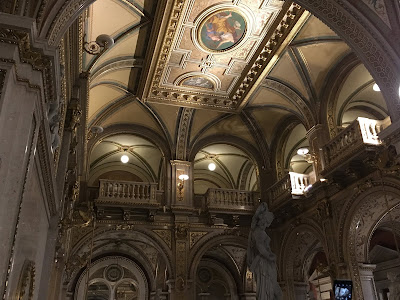I was very surprised by our check in at the Vienna airport. My past experience has been that you can't get to the airport too early because the ticket counters are shared between airlines and don't open until just before the flight, so you end up standing around (no seating), waiting for the ticket counter to open and then rush through security and rush to board your flight. However, this time the check in was almost entirely automated and was open when we arrived. It was very easy. Even the process of putting our luggage on the conveyor was automated. Only 2 staffers were there to manage the process and they were not overwhelmed with errors by the system. Remarkable. I couldn't help but think, however, 'these used to be jobs for people'...
We proceeded to security, where Delaney was pulled aside because she had her breakfast yogurt in her bag. Rather than simply confiscating it, the agent asked her if she wanted to step aside and eat it, which she did. This would have NEVER happened with TSA. They did not require us to take off our shoes. In fact they had a special 'shoe scanner' that you could put your foot in if you had shoes that were risky (ie boots?). Another member in our group had her bag searched, and she explained that the whole time the agent was apologizing while searching it. These two experiences left us feeling very positive about security, rather than disgruntled and violated as is often the case with TSA. Its amazing how a little bit of humanity can change people's attitudes.
We got to experience the TSA upon our return to Atlanta - loud yelling about which line to stand in, brusk, almost angry, repeated instructions about what to put in the tray and take off. It leaves you feeling stupid and like some kind of criminal.
On a side note, the transfer between terminals in Charles de Gaulle airport is crazy. All of the "L" gates are in terminals 2E and 2 F. All of the "M" gates are in terminal 2E. All of the "K" gates are in terminal 2E. There are also terminals 2D and 2A and 2C. I have no idea what happened to terminal 2B or why the gates don't correspond with the terminal letters!
Oh, and if you need to get between terminals, its a bus that takes about 30 mins to make a full loop (blue loop). Possibly with a transfer to another loop bus if you have to go to Terminal F or Terminal G. Crazy.
Made it home at 9:30 pm (3:30 am Vienna time) - our 24 hour transit is complete!




















































